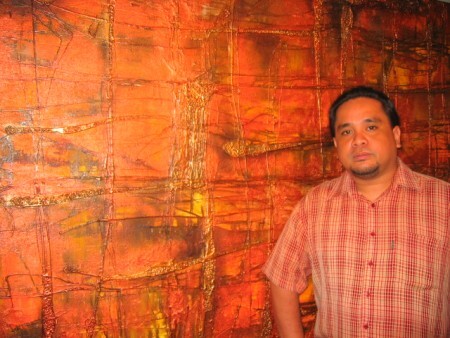Sio Montera
The cause of modernism by Raymund Fernandez, Cebu Daily News 08/29/2007
Showing now at the SM Art Center is Dennis “Sio” Montera’s one-person show of paintings, entitled “Free Forms.” Featured here are formalist, abstract paintings, which are in a way unprecedented for their sizes and consistency of style.
Dennis is one among the younger generation faculty of UP Cebu College Fine Arts Program. He recently finished his Masters of Fine Arts degree at UP Diliman. Prior to his undergraduate studies at UP Cebu, he trained under such artists as Mar Vidal. He is acquainted with the painting techniques of the local realists and once painted using the color principles taught by the late Cebuano master Martino Abellana, which he learned from the master’s students.
Most of his early naturalistic works orbited around the phenomenon of food. This was a natural consequence traced to his fondness for travel, especially to beach resorts. He takes his students regularly for painting sessions on the beaches of Bantayan Island. For these sorties he would often be accompanied by his barkada of artists, now organized into the art group Tuslob Buwa Ltd. The group holds regular summer art workshops at SM, as well as regular group shows done usually around a theme. Jojo Sagayno, one of the members of this group and currently teaching at the Fine Arts Department of University of San Carlos, spoke of a regular activity they hold on New Year’s Eve: they would go around the downtown area giving food to the people living on the streets.
Given this orientation, it is only expected that the group should espouse some higher cause. This cause is the cause of modernism and, being the young artists that they are, the cause of modernism is for them the battle cry for change. This, of course, is an assertion that cannot help but raise discussion and argument, especially that sort of argument that Western modernists had traditionally tried to escape from. Jackson Pollock, who was the great icon of Western modernism, had always stayed away from spoken and written discourses. He had the art critic and staunch supporter Clement Greenberg to do all the talking for him.
One might argue if modernism really represents any change at all, even in our locality. Abellana, after all, had done non-objective abstractionist paintings, some dated in the early sixties. On the other hand, there is already an established tradition of non-objective art making here. We have abstractionists like Tito Cuevas, Andrew Barba, Vidal Alcoseba, etc., who have worked in this genre for many years now. But it is true that the local audience for art is still stuck up with a type of naturalistic realism, most likely rooted to the feudalistic agricultural system, which still persists. Thus, clearly, the battle for modern art is yet to be won in the local setting.
I am not an abstractionist. My affinity is for post-modernism rather than for what has by now become mainstream, modernist art in the Philippine setting. Even so, I do have a lot of sympathy for any effort whatsoever to enhance modernism in our local community and country. Thus, I am inclined to give the local modernists my full measure of support. This is the reason why I feel they should increase the effort to clarify the philosophical basis of their art, especially in the literature that accompanies the work.
The paintings are by themselves exceptional but they are not themselves capable of artistic revolution. What modernists should do is to clarify, hopefully in vivid terms, their context in the local culture. We know the appearance of the works they like to produce. But because we are not a Western culture nor are we a fully westernized one, we cannot help but ask: What do modernists want for us? What do they envision for us in the future world? How should we view their works?

